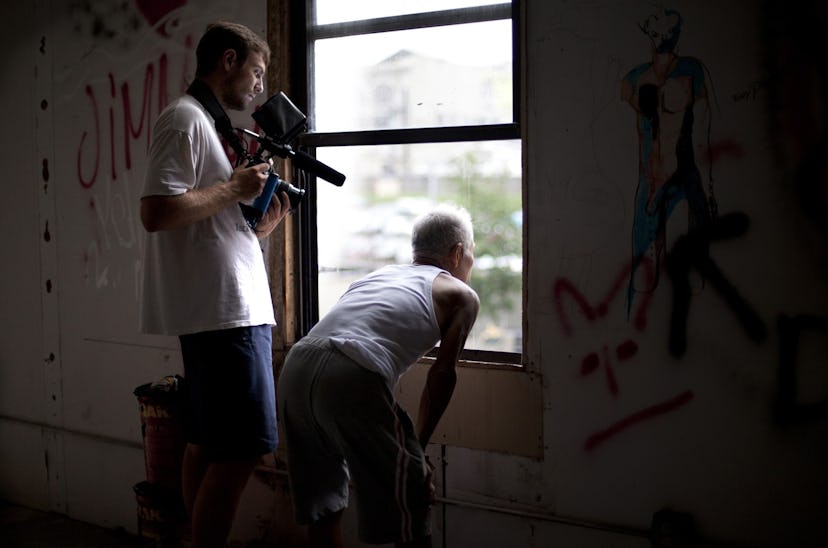Five Minutes with Director Zachary Heinzerling
The director takes us behind the making of his new documentary, Cutie and the Boxer.

Ushio and Noriko Shinohara, the couple at the center of director Zachary Heinzerling’s new documentary Cutie and the Boxer, have a complicated history that results in an unusual dynamic: he was a budding action painter and sculptor in the late ‘60s downtown New York art scene when she, an aspiring artist twenty years his junior, shelved her own creative aspirations to become his assistant. Today, their union is a complicated mix of worn-in love and deep resentment, depicted most clearly in Noriko’s work: black and white illustrations of a relationship based on their own. (Her character is called Cutie, his, tellingly, is named Bullie.) The couple inhabits an ancient New York City apartment, preparing meals together and working on their individual art like “two flowers in one pot,” as Noriko describes it—and, of course, bickering. “It’s kind of rare that you find people that live that romantic idea of the artist,” Heinzerling says of the pair. Here, the director talks about the experience of making the documentary.
How did you first meet Ushio and Noriko? We were introduced by a mutual friend in 2008 and I made a short film about them, kind of a day in the life. Then, I just kept going over there and going over there, sometimes with a camera, sometimes not. They’re really fun personalities but I knew that, after seeing Noriko’s work, there was real sadness, anger, resentment and tension beneath their beauty and spirit.
Did you know who Ushio was before you started making the short film? Not at all. And while I studied art history in school and I am interested in art, that wasn’t really the pull. It was more the connection between their personalities and their art, how pure the connection was and how honest it felt.
Much of the film is in Japanese. Did you have a translator with you? How did you know if you were getting an interesting conversation or not? I really didn’t know. It’s a very inefficient way of making a film, but I think kind of the only way. I could understand a little bit of Japanese, but the majority of the conversations were just filmed in their entirety and then translated after the fact. A lot of the challenge was figuring out ways of making myself more invisible. Noriko calls me her rice cooker—I was just there all the time, another object in the apartment.
There’s an emotional scene in the middle of the film that is created from archival footage. Where did that come from? I got really lucky with that. Their place is just kind of littered with photographs and footage. Each time I would go I would just collect more and more tapes. On one tape that had a Michael Jackson concert on it—Ushio’s obsessed with Michael Jackson—there was also a part of this documentary that one of their friends was trying to make. He was really just filming these parties that they were having. He had miraculously saved all of the original tapes and he sent them to me.
What about the scene at the very end of the film that depicts the two in a slow motion boxing match? Was that arranged or spontaneous? I brought the idea up with Noriko and she liked it so she went out and bought a pair of pink boxing gloves. Ushio was a little bit hesitant, and as you can tell, he doesn’t really punch back. But Noriko just kind of seized the opportunity and went after it.
It seems like a nice release for her. Yeah, that’s her favorite part of the movie.
The trailer for Cutie and the Boxer
You had a strong point of view in terms of the look and feel of the film, from the color scheme to the music. Had you decided about that before you started editing? Immediately when I met them I knew that I could make something really visually interesting. They actually have really great style. All of Noriko’s clothes are really interesting and a lot of the colors are just these pastels that are really faded—clearly they’ve worn these t-shirts for thirty years or something. I wanted the look of the film to be kind of de-saturated and playing up these pastel colors so we used these lenses that have a softer feel. The style of the film in some ways mimics the mood of Noriko’s art, this kind of happy-sad tone.
The movie is just as much being an artist as it is about being in a long-term relationship. Did it make you change the way that you think about relationships and your own art? I came to realize that people are together for reasons that are kind of impossible to explain, and it’s hard to define why people are right for each other. I think I aged a bit or certainly have a more mature view of relationships as a result. In terms of art, they were constantly working and that fed my energy to continue with the project in a way.
Ushio is 80-years-old and seems so young. He has so much energy. It’s pretty crazy. He’s really fit. Everything that he does, he uses his whole body.
Do you keep in touch? Yeah, for sure. They kind of treat it like its their movie too, which is good. Our relationship is in some ways more even now because I don’t have the camera; it’s less about me investigating their lives and we’re a little bit more on even plains. I had the camera as a weapon to intrude and investigate, but now it’s just a much more normal kind of friendship, which is nice.
Cutie and the Boxer opens Friday, August 16 in New York City at Sunshine Cinemas and Lincoln Plaza Cinemas.